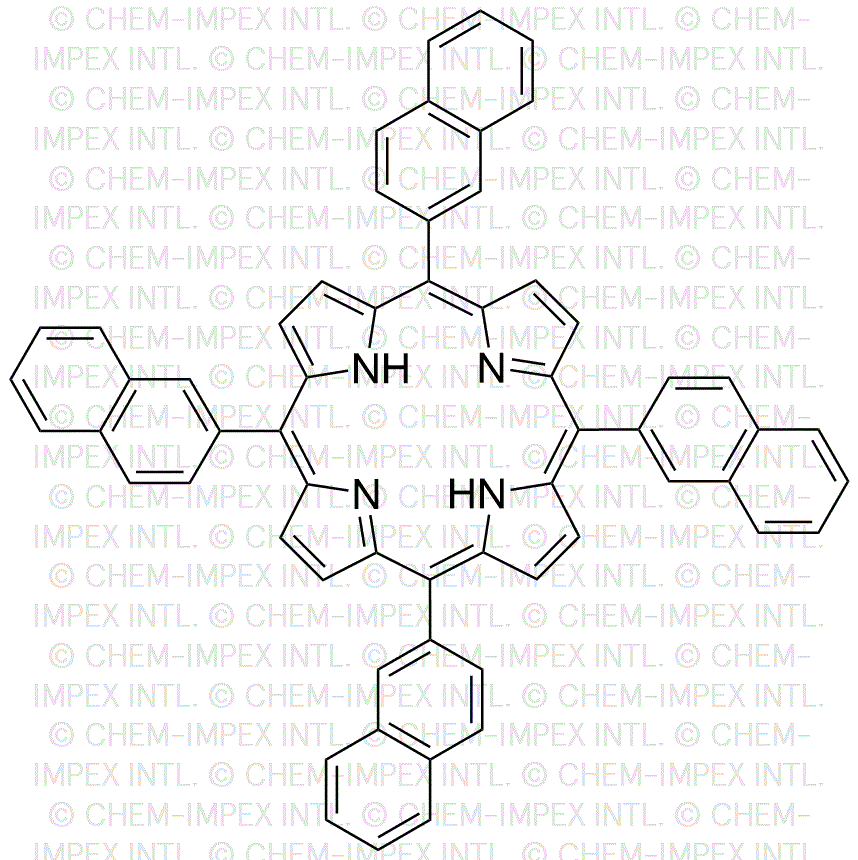5,10,15,20-(Tetra-2-naphthalenyl)porphyrin is widely utilized in research focused on:
- Photodynamic Therapy (PDT): This compound is effective in PDT, a treatment that uses light-activated drugs to kill cancer cells, making it a promising option in oncology.
- Solar Energy Conversion: Its unique structure allows for efficient light absorption, which can be harnessed in solar cells to improve energy conversion rates.
- Fluorescent Probes: The compound can be used as a fluorescent marker in biological imaging, helping researchers visualize cellular processes with high precision.
- Catalysis: It serves as a catalyst in various chemical reactions, enhancing reaction rates and selectivity in organic synthesis, which is beneficial for pharmaceutical development.
- Material Science: Its properties are leveraged in the development of advanced materials, including sensors and organic light-emitting diodes (OLEDs), contributing to innovations in electronics.
General Information
Properties
Safety and Regulations
Applications
5,10,15,20-(Tetra-2-naphthalenyl)porphyrin is widely utilized in research focused on:
- Photodynamic Therapy (PDT): This compound is effective in PDT, a treatment that uses light-activated drugs to kill cancer cells, making it a promising option in oncology.
- Solar Energy Conversion: Its unique structure allows for efficient light absorption, which can be harnessed in solar cells to improve energy conversion rates.
- Fluorescent Probes: The compound can be used as a fluorescent marker in biological imaging, helping researchers visualize cellular processes with high precision.
- Catalysis: It serves as a catalyst in various chemical reactions, enhancing reaction rates and selectivity in organic synthesis, which is beneficial for pharmaceutical development.
- Material Science: Its properties are leveraged in the development of advanced materials, including sensors and organic light-emitting diodes (OLEDs), contributing to innovations in electronics.
Documents
Safety Data Sheets (SDS)
The SDS provides comprehensive safety information on handling, storage, and disposal of the product.
Product Specification (PS)
The PS provides a comprehensive breakdown of the product’s properties, including chemical composition, physical state, purity, and storage requirements. It also details acceptable quality ranges and the product's intended applications.
Certificates of Analysis (COA)
Search for Certificates of Analysis (COA) by entering the products Lot Number. Lot and Batch Numbers can be found on a product’s label following the words ‘Lot’ or ‘Batch’.
*Catalog Number
*Lot Number
Certificates Of Origin (COO)
This COO confirms the country where the product was manufactured, and also details the materials and components used in it and whether it is derived from natural, synthetic, or other specific sources. This certificate may be required for customs, trade, and regulatory compliance.
*Catalog Number
*Lot Number
Safety Data Sheets (SDS)
The SDS provides comprehensive safety information on handling, storage, and disposal of the product.
DownloadProduct Specification (PS)
The PS provides a comprehensive breakdown of the product’s properties, including chemical composition, physical state, purity, and storage requirements. It also details acceptable quality ranges and the product's intended applications.
DownloadCertificates of Analysis (COA)
Search for Certificates of Analysis (COA) by entering the products Lot Number. Lot and Batch Numbers can be found on a product’s label following the words ‘Lot’ or ‘Batch’.
*Catalog Number
*Lot Number
Certificates Of Origin (COO)
This COO confirms the country where the product was manufactured, and also details the materials and components used in it and whether it is derived from natural, synthetic, or other specific sources. This certificate may be required for customs, trade, and regulatory compliance.


